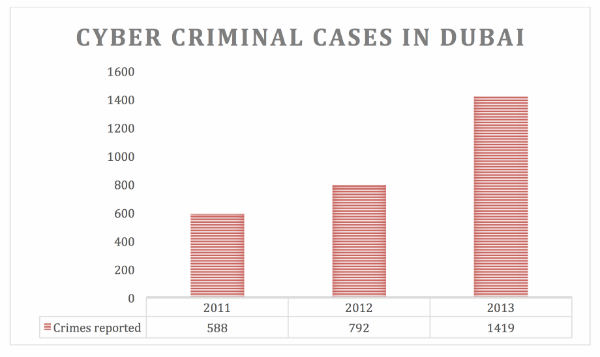Although the virtual environment of the global network is a comparatively new concept, it has already been inundated with cybercriminals (Yar, 2013). The phenomenon of a cybercrime dates back to 1971, when the web was first invaded by the virus notoriously known as Creeper (The evolution of the computer virus, n. d.); it was very simple by the present-day standards, yet it managed to cause havoc across the Internet (Ruiz & Winter, 2015).
Unfortunately, viruses and other tools used by cybercriminals are only getting smarter and becoming increasingly more sophisticated, causing a global concern regarding people’s personal information and companies’ business data. A similar situation can be observed in the UAE (Enzer, 2011). Although the recent introduction of updates to the cybercrime law impose a set of rather severe penalties on the offenders, including a life sentence, the specified regulation is not going to have a tangible effect on cybercriminals as it does not allow for a willing acceptance of proper behavioral patterns and the recognition of cybercrime as an intrinsically negative phenomenon. Therefore, the development of programs aimed at changing the target audience’s concept of cybercrime is crucial.
The fact that the current legislation reinforces the significance of the letter of the law, however, should be viewed as positive. For instance, on the city scale, the regulation regarding cybercrimes has affected Dubai to a considerable extent as the police persuades people to report about the cybercrimes that they have witnessed or fallen victims to: “Dubai Police have urged victims of online social networking sites to approach authorities because their hesitation encourages suspects to target more victims” (Najami, 2010, par. 1).
Nevertheless, the lack of information regarding the concept of cybercrime, the ways of inhibiting it, the tools that every single member of the UAE society can use to prevent cybercrimes, etc., is obvious seeing that the number of problems created by hackers and crimes committed online is getting increasingly larger in the UAE, in general, and Dubai, in particular (See Fig. 1).

According to the chart provided above, the introduction of the new legislation has contributed to a minor drop in cybercrimes. However, the specified measure is also likely to spur the further identification of new ways to evade justice as it does not allow for a conscious change of the target audience’s behavioral patterns (Najami, 2010). Therefore, it would be adequate to suggest that the focus should be shifted from providing penalties to reinforcing knowledge promotion among the target denizens of the population. In addition, it can be suggested that programs should be created to educate people on the issue of cybercrimes. Thus, significant progress can be expected.
Reference List
Enzer, G. (2011). UAE faces high rates of cyber-crime. Web.
The evolution of the computer virus. (n. d.). Web.
Hasbini, M. A. (2014). The rise of cybercrime in Dubai and UAE. SecureList. Web.
Najami, S. A. (2010). Dubai Police urge victims to report online crimes. Gulf News. Web.
Ruiz, R., & Winter, R. (2015). Apoc@lypse: The end of antivirus. Web.
Yar, M. (2013). Cybercrime and society. Thousand Oaks, CA: SAGE.